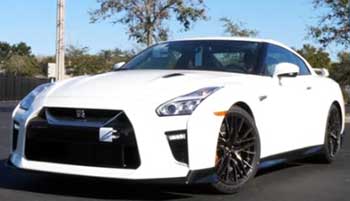
I’ve always been drawn to cars that don’t just perform but tell a story through their raw power and engineering grit.
The Nissan GT-R and GT-R Nismo are legends in their own right, and I’m here to share my firsthand experience comparing these two titans.
This article unpacks their differences, weighing the pros and cons, offering maintenance insights, and answering your burning questions.
Whether you’re a gearhead or just curious, I’ll break down what makes each model unique, helping you decide which Godzilla suits your drive.
Comparison Table
| Feature | Nissan GT-R Premium | Nissan GT-R Nismo |
|---|---|---|
| Engine | 3.8L Twin-Turbo V6 | 3.8L Twin-Turbo V6 |
| Horsepower | 565 hp | 600 hp |
| Torque | 467 lb-ft | 481 lb-ft |
| 0-60 mph | 2.9 seconds | 2.5-2.7 seconds |
| Top Speed | 195 mph | 205 mph |
| Weight | ~3,935 lbs | ~3,814 lbs |
| Transmission | 6-speed dual-clutch | 6-speed dual-clutch |
| Suspension | Bilstein adaptive | Nismo-tuned Bilstein |
| Brakes | Brembo carbon-ceramic | Larger carbon-ceramic |
| Price (2024) | ~$120,990 | ~$220,990 |
| Key Features | Apple CarPlay, leather seats | Carbon-fiber components, Recaro Podium seats |
| Track Focus | Balanced road/track | Track-optimized |
My Experience With The Nissan GT-R
I’ll never forget the first time I slid into the driver’s seat of a Nissan GT-R Premium. The cabin felt like a cockpit, with leather-wrapped surfaces and an 8-inch touchscreen that, while not cutting-edge, got the job done.
The roar of the 3.8-liter twin-turbo V6 was intoxicating as I punched the accelerator, hitting 60 mph in a blistering 2.9 seconds. It’s a car that feels alive, blending brute force with surprising daily usability. On city streets, it’s manageable, though the firm suspension reminds you it’s built for more than grocery runs.
Then came the GT-R Nismo. From the moment I gripped the Alcantara steering wheel, I knew this was a different beast. The Recaro Podium seats hugged me tighter, and the carbon-fiber accents screamed performance.
On a track day, the Nismo’s 600 horsepower and sharper handling made every corner a thrill, though its stiffer ride was less forgiving on public roads. The Nismo felt like it was daring me to push harder, with a raw edge that’s both exhilarating and demanding.
Both cars share the same DNA, but the Nismo is the GT-R’s wilder sibling, tuned for track dominance with a price tag to match. The Premium, however, balances supercar performance with enough comfort for daily driving. Choosing between them depends on how much you crave that track-ready edge versus versatility.
My Experience With The Nissan GT-R Nismo
The Nismo experience is intense. The moment I fired up the engine, the cabin filled with a deeper, throatier growl, thanks to the titanium exhaust. On the track, the Nismo’s precision was surgical—its limited-slip front differential and re-tuned suspension made it carve corners like a scalpel.
But on regular roads, the stiff setup and lower ground clearance had me wincing over potholes. The carbon-fiber bodywork, from the hood to the swan-neck spoiler, not only looks menacing but shaves weight, making the Nismo feel lighter on its feet.
Yet, the Nismo demands respect. Its track-focused nature means it’s less practical for daily use, and the $220,990 price tag is a gut punch compared to the Premium’s $120,990.
Still, for those who live for the thrill of pushing limits, the Nismo delivers an unmatched rush. It’s a car that feels like it’s always ready to pounce, whether you’re chasing lap times or just flexing at a car meet.
Pros Of The Nissan GT-R
- Iconic Performance: The 565-horsepower twin-turbo V6 delivers jaw-dropping acceleration, hitting 60 mph in 2.9 seconds, rivaling cars twice its price.
- All-Wheel-Drive Grip: The GT-R’s advanced AWD system provides exceptional traction, making it a beast in all weather conditions, from rain-soaked roads to dry tracks.
- Daily Drivability: With a smoother ride than the Nismo, heated leather seats, and Apple CarPlay, it’s surprisingly livable for a supercar.
- Affordable Supercar Status: Starting at $120,990, it offers performance that punches way above its price, undercutting rivals like the Porsche 911 Turbo S.
- Customizable Driving Modes: Three toggle switches let you tweak suspension, powertrain, and stability control, making it versatile for city or track.
- Heritage Appeal: Iconic colors like Midnight Purple and a legacy tied to the Skyline GT-R make it a collector’s dream.
- Reliable Engineering: The hand-built VR38DETT engine is a proven workhorse, with a reputation for durability when maintained properly.
The GT-R’s blend of raw power and practicality won me over. It’s a car you can drive to work, then take to the track and embarrass pricier exotics. The AWD system gives confidence in any condition, and the price-to-performance ratio is hard to beat. While the infotainment feels dated, the driving experience is timeless.
Cons Of The Nissan GT-R

- Outdated Infotainment: The 8-inch touchscreen lacks modern polish, and the absence of Android Auto is a letdown for tech-savvy drivers.
- Firm Ride: Even in its softest setting, the Bilstein suspension can feel harsh on rough roads, making long drives less comfortable.
- Fuel Economy: Expect 16-18 mpg combined, which isn’t surprising for a supercar but stings at the pump.
- Limited Rear Space: The 2+2 layout is more for show; rear seats are cramped and better suited for bags than passengers.
- Aging Platform: Launched in 2007, the R35 feels dated against newer rivals with sharper tech and lighter builds.
- Maintenance Costs: Specialized parts and labor for the hand-built engine and AWD system can lead to hefty repair bills.
- Not As Exclusive: The Premium trim, while iconic, lacks the rarity and bespoke feel of the Nismo or limited editions.
The GT-R’s age shows in its tech and ride quality. While it’s a performance bargain, the dated cabin and high maintenance costs remind you it’s not perfect. For daily driving, the firm suspension and tight rear seats can be a hassle, especially if you’re used to more refined sports cars.
Read more: My Thoughts on Honda Odyssey Vs. Subaru Ascent
Pros Of The Nissan GT-R Nismo
- Track-Ready Performance: With 600 horsepower and a 0-60 time as low as 2.5 seconds, it’s a supercar-killer on the track.
- Lightweight Design: Carbon-fiber hood, roof, and spoiler shave over 30 kg, improving agility and handling precision.
- Enhanced Brakes: Larger carbon-ceramic brakes offer phenomenal stopping power, perfect for aggressive track sessions.
- Nismo-Tuned Suspension: Stiffer springs and re-valved dampers make it corner like it’s on rails, with minimal body roll.
- Exclusive Styling: The swan-neck spoiler, red-accented wheels, and Stealth Gray paint scream bespoke performance.
- Recaro Podium Seats: These carbon-fiber-backed seats are both supportive and luxurious, enhancing the track experience.
- Aerodynamic Mastery: Increased downforce from revised aero components keeps it planted at high speeds.
The Nismo is a track junkie’s dream. Its razor-sharp handling and raw power make every lap exhilarating. The lightweight materials and exclusive styling add a sense of occasion, making it feel like a true special edition. It’s a car that begs you to push its limits.
Cons Of The Nissan GT-R Nismo
- Eye-Watering Price: At $220,990, it’s nearly double the Premium’s cost, putting it in Porsche 911 Turbo S territory.
- Harsh Ride: The Nismo-tuned suspension is unforgiving on public roads, making daily driving a chore.
- Limited Practicality: With even less rear seat usability and a smaller trunk, it’s less versatile than the Premium.
- High Maintenance Costs: Carbon-ceramic brakes and specialized components mean repairs are astronomically expensive.
- Fuel Efficiency: Like the Premium, it guzzles gas, with combined mpg in the mid-teens.
- Niche Appeal: Its track focus alienates buyers looking for a more balanced supercar for daily use.
- Infotainment Lag: The same dated 8-inch touchscreen carries over, feeling out of place in a $200,000+ car.
The Nismo’s price and harsh ride are tough pills to swallow. It’s a car built for the track, not comfort, and the maintenance costs can be a nightmare. If you’re not hitting the circuit regularly, the Premium offers similar thrills for far less.
Maintenance Tips For The Nissan GT-R
- Regular Oil Changes: Use high-quality synthetic oil (5W-30 or 5W-40) every 3,000-5,000 miles to keep the VR38DETT engine healthy. This hand-built engine is robust but sensitive to neglect.
- Transmission Fluid Checks: The dual-clutch transmission requires fluid changes every 18,000 miles or 3 years. Use Nissan’s specified fluid to avoid costly damage.
- Tire Maintenance: Rotate the Dunlop or Michelin tires every 6,000 miles to ensure even wear, especially given the AWD system’s demands. Check pressures monthly (38-40 psi cold).
- Brake Inspections: Inspect Brembo brakes every 10,000 miles for pad wear. Carbon-ceramic options on higher trims need careful monitoring due to replacement costs.
- Cooling System Care: Flush the coolant every 30,000 miles to prevent overheating, as the twin-turbo V6 generates significant heat under hard driving.
- Suspension Checks: Have the Bilstein adaptive dampers inspected annually for leaks or wear, especially if you push the car on rough roads or tracks.
- Software Updates: Visit a certified Nissan dealer for ECU and transmission software updates to maintain optimal performance and address known issues.
Maintaining a GT-R is like caring for a racehorse—it’s rewarding but demands attention. I learned the hard way that skipping oil changes can lead to turbo lag, and tire neglect hurts grip. Regular dealer visits for software tweaks keep the car running smoothly, but budget for pricier parts compared to a standard sports car.
Maintenance Tips For The Nissan GT-R Nismo

- Specialized Oil Changes: Use premium synthetic oil (0W-40 for track use) every 3,000 miles due to the Nismo’s higher-performance engine tuning.
- Carbon-Ceramic Brake Care: Inspect brakes every 5,000 miles or after track sessions. Replacements can cost $10,000+, so avoid aggressive street driving.
- Tire Replacement: The Nismo’s Dunlop SP Sport Maxx GT600 tires wear faster on tracks; replace every 10,000-12,000 miles or sooner if tracking frequently.
- Carbon-Fiber Inspections: Check carbon-fiber components (hood, spoiler) for cracks or UV damage annually, as repairs are costly and affect aesthetics.
- Transmission Maintenance: Change the dual-clutch fluid every 15,000 miles due to the Nismo’s aggressive shifting. Use only Nissan-approved fluid.
- Cooling System Upkeep: Flush coolant every 25,000 miles to handle the extra heat from track use. Inspect intercooler pipes for leaks.
- Suspension Tuning: Have Nismo-tuned Bilstein dampers checked every 8,000 miles for optimal track performance. Misalignment can ruin handling.
The Nismo’s maintenance is a step up in cost and complexity. I’ve found that track days accelerate wear on tires and brakes, so budgeting for frequent replacements is key. Regular inspections of carbon-fiber parts and the cooling system prevent headaches, as this car thrives on precision care.
Read more: My Thoughts on GMC Terrain Vs. Ford Escape
Frequently Asked Questions (FAQ)
The GT-R Nismo has a tuned 3.8L V6 with 600 hp (vs. 565 hp), lighter carbon-fiber components, a track-focused suspension, and larger carbon-ceramic brakes. It’s pricier ($220,990 vs. $120,990) and less practical for daily driving.
Nismo models feature enhanced power (600 hp), carbon-fiber bodywork, a stiffer suspension, upgraded brakes, and exclusive styling like the swan-neck spoiler and Recaro Podium seats, prioritizing track performance.
The GT-R Nismo is the fastest, with a 0-60 mph time of 2.5-2.7 seconds and a top speed of 205 mph, compared to the Premium’s 2.9 seconds and 195 mph.
Nismo stands for Nissan Motorsport, Nissan’s performance division focused on racing-inspired engineering, tuning, and styling for enhanced power and handling.
Conclusion: For The Nissan GT-R And GT-R Nismo
You’re now armed with the full scoop on the Nissan GT-R and GT-R Nismo. The Premium GT-R is your go-to if you want a supercar that doubles as a daily driver without breaking the bank. It’s a legend that delivers thrills and practicality.
The Nismo, though, is for those who live for the track, offering unmatched precision at a premium price. Both are icons, but your choice hinges on whether you prioritize versatility or pure performance. Pick your Godzilla, and let it roar.

